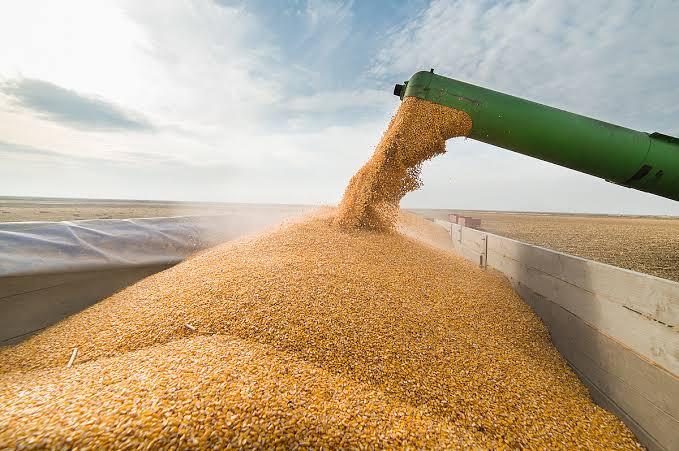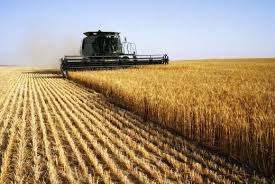Farm yield refers to the amount of crops or produce that farmers get from their fields or land. It’s like the reward for all the hard work they put into growing plants. Think of it as the number of potatoes, carrots, or wheat that a farmer gets after planting seeds and caring for the crops.
The yield can change based on many things. Weather plays a big role. If it’s sunny and rainy when the plants need it, they can grow big and healthy, giving more yield. But if there’s a drought or too much rain at the wrong time, the yield might be smaller.
Another thing that affects farm yield is the type of soil. Some soils are rich in nutrients, making it easier for plants to grow and produce more. But if the soil lacks those nutrients, it might limit the yield.
Farmers also use different techniques to improve yield. They might use fertilizers or pesticides to protect the plants from bugs and help them grow better. Some farmers even use advanced technology like drones or sensors to monitor their fields and make sure everything is just right for the plants.
Sometimes, the yield isn’t just about the quantity of crops but also about the quality. Farmers might aim for higher quality produce that can be sold for a better price. So, they might focus on methods that improve the taste, size, or appearance of the crops.
The goal for many farmers is to increase their yield while taking care of the environment. They might use sustainable practices that keep the soil healthy for future crops or use less water to grow more efficiently. It’s like a balance between getting a good yield and making sure the land stays good for farming in the long run.
Farm yield is like the harvest at the end of a journey. It’s the result of the farmer’s hard work, the cooperation of nature, and the use of different techniques to grow the best crops possible.
Farmers put a lot of effort into understanding their crops and the land they work on. They study which plants grow best in their area, considering factors like temperature, rainfall, and soil type. This knowledge helps them decide what to plant and when to plant it to get the best yield.
Crop rotation is a strategy some farmers use to improve yield. Instead of planting the same crop in the same place every year, they switch it up. For example, one year they might plant corn, and the next year, they might plant beans. This helps keep the soil healthy and prevents the depletion of specific nutrients that certain plants need more of.
When it comes to modern farming, technology is a big helper in increasing yield. Farmers use machinery like tractors, harvesters, and irrigation systems to work more efficiently and cover larger areas of land. These tools save time and energy, allowing farmers to focus on other aspects that can further improve yield.
Genetic modification is another way farmers try to enhance yield. Scientists work on creating crops that are more resistant to diseases, pests, or extreme weather conditions. These modified crops can sometimes produce larger yields or thrive better in certain environments.
Farmers also pay attention to the timing of planting and harvesting. They follow schedules based on the seasons and the life cycle of the crops. If they plant too early or too late, it can affect the yield. Harvesting at the right time ensures that the crops are at their peak quality and quantity.
Additionally, education and knowledge-sharing among farmers play a vital role in improving yield. Farmers attend workshops, seminars, or even use online resources to learn about new techniques, innovations, and best practices in agriculture. This continuous learning helps them adapt and apply better methods on their farms.
Farm yield isn’t just about the number of crops; it’s about finding ways to grow more food efficiently while taking care of the land. It’s a constant journey of learning, adapting, and using the best available tools and knowledge to produce food for the world.
Read Also: Thin Paspalum (Paspalum setaceum) Growing and Care Guide
Techniques for Enhancing Farm Yield

Techniques for enhancing farm yield involve a variety of approaches and practices aimed at optimizing crop production. Here are some key methods:
1. Precision Agriculture: Utilizing technology like GPS, sensors, and drones to analyze and manage fields more precisely. This helps farmers understand variations in soil fertility, moisture levels, and crop health, allowing for targeted interventions and optimized resource use.
2. Improved Seed Varieties: Developing and using seeds that are more resilient to pests, diseases, and harsh environmental conditions. This includes traditional breeding techniques as well as genetically modified (GM) crops designed for higher yields and better resistance.
3. Effective Irrigation Systems: Implementing efficient irrigation methods such as drip irrigation or precision watering systems. These techniques provide the right amount of water at the right time, reducing waste and ensuring plants receive adequate hydration.
4. Optimal Fertilization: Employing fertilizers to enhance soil fertility and provide essential nutrients to plants. Controlled and balanced application of fertilizers helps maintain soil health, supporting robust crop growth and higher yields.
5. Integrated Pest Management (IPM): Implementing strategies to manage pests, diseases, and weeds using a combination of biological control, cultural practices, and minimal use of pesticides. This approach minimizes environmental impact while safeguarding crop health.
6. Crop Rotation and Diversification: Alternating crops in a specific sequence to avoid depleting soil nutrients and controlling pests naturally. Diversification can improve soil structure and fertility while reducing disease incidence.
7. Conservation Tillage: Minimizing soil disturbance during planting by using techniques like no-till or reduced-till farming. This helps retain moisture, prevents erosion, and preserves soil health, contributing to increased yields.
8. Post-Harvest Management: Implementing proper storage, handling, and processing techniques to preserve crop quality and reduce losses. This includes appropriate storage conditions and efficient transportation methods.
By integrating these techniques and adapting them to local conditions, farmers can significantly enhance farm yield while promoting sustainable and environmentally friendly agricultural practices.
Factors Influencing Farm Yield
Several factors significantly influence farm yield. Understanding and managing these factors are crucial for farmers to optimize their crop production. Here are some key influencers:
1. Weather Conditions: Weather plays a pivotal role in farm yield. Adequate sunlight, optimal temperatures, and timely rainfall promote healthy plant growth. Conversely, extreme weather events like droughts, floods, or storms can adversely affect yield.
2. Soil Quality: The health and fertility of the soil are vital. Soil with balanced pH levels, adequate nutrients, good structure, and proper drainage supports robust crop growth. Different crops thrive in specific soil types, so understanding and managing soil quality is crucial.
3. Water Supply: Access to water, whether through natural rainfall or irrigation systems, is essential for crop growth. Insufficient or excess water can lead to stunted growth, reduced yield, or even crop failure.
4. Pests, Diseases, and Weeds: These biological factors can significantly impact farm yield. Pests feeding on crops, diseases affecting plant health, and invasive weeds competing for resources can reduce the quantity and quality of the harvest.
5. Genetic Factors: The choice of crop varieties or seeds used in farming greatly influences yield. Selecting seeds that are well-suited to local conditions, with traits like high yield potential, resistance to pests/diseases, and tolerance to environmental stressors, can boost productivity.
6. Agricultural Practices: Farming techniques, such as tillage methods, fertilization, irrigation, and pest control strategies, directly impact yield. Employing sustainable and efficient agricultural practices can enhance crop productivity while preserving the environment.
7. Timing of Planting and Harvesting: Planting crops at the right time and harvesting them when they reach optimal maturity levels are critical factors affecting yield. Timely actions ensure that crops have adequate time to grow and reach their full potential.
8. Technology and Innovation: Advancements in agricultural technology, including machinery, precision farming tools, biotechnology, and improved farming practices, can significantly impact yield by increasing efficiency and productivity.
Managing these factors requires a holistic approach that considers the interplay between natural elements, agricultural practices, and technological advancements. Farmers who effectively navigate these variables often achieve higher yields and contribute to sustainable agricultural practices.
Read Also: How to Grow, Use and Care For Thinfruit Sedge (Carex flaccosperma)
Economics and Market Implications of Farm Yield

The economics and market implications of farm yield have a substantial impact on agricultural practices, food availability, and global economies. Here’s an exploration of these aspects:
1. Market Prices and Supply-Demand Dynamics: Farm yield directly influences the supply of crops in the market. Higher yields can lead to increased supply, potentially affecting market prices. Conversely, low yields might result in reduced supply, leading to price fluctuations. The balance between supply and demand influences market stability and price levels.
2. Food Security and Access: Farm yield is closely linked to food availability. Higher yields can contribute to increased food supply, potentially lowering prices and improving access to food. Adequate farm yield plays a critical role in ensuring food security by meeting the nutritional needs of populations.
3. Income for Farmers: Higher farm yield can translate to increased income for farmers. When farmers produce more, they can sell more crops, generating higher revenues. However, fluctuations in market prices and production costs can impact the profitability of farming operations.
4. Economic Contributions: Agriculture contributes significantly to the economies of many countries. Higher farm yields can positively impact a nation’s GDP by boosting agricultural output, creating employment opportunities, and supporting related industries such as food processing and distribution.
5. International Trade and Exports: Farm yield influences a country’s ability to export agricultural products. Higher yields can lead to surplus production, enabling countries to export excess crops to international markets. This can contribute to foreign exchange earnings and trade balance.
6. Impact on Input Costs: The economics of farm yield also involves the costs associated with inputs such as seeds, fertilizers, machinery, and labor. Higher yields might necessitate increased inputs, impacting production costs and overall profitability for farmers.
7. Sustainability and Long-term Economic Viability: Balancing farm yield with sustainable agricultural practices is crucial for long-term economic viability. Sustainable practices ensure the preservation of natural resources, maintaining fertile soils, and safeguarding ecosystems, which are essential for consistent and stable yields over time.
Understanding the economics and market implications of farm yield is vital for policymakers, farmers, and stakeholders within the agricultural sector. Striking a balance between maximizing yield, ensuring economic viability, and promoting sustainable practices is key to fostering a resilient and thriving agricultural industry.
Read Also: Vegetarian Meal Prep Ideas
